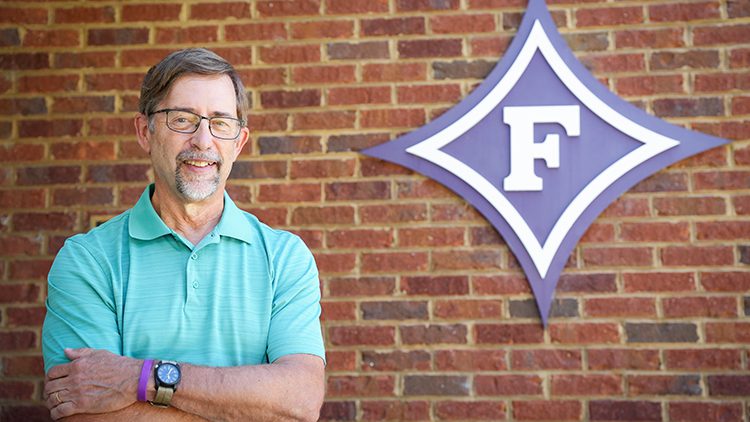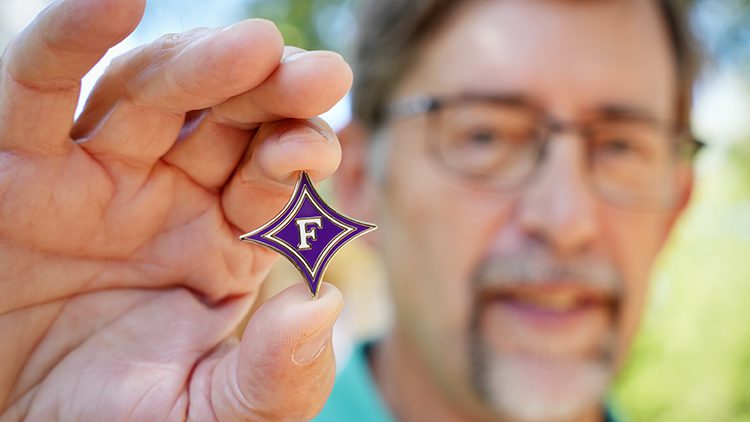As Furman’s Diamond F logo turns 50, student creator looks back

One spring day in 1973, Dennis Zeiger ’74, a quarter-miler on the Furman track team and an art major, walked through Alley Gym and past the football coaches’ offices on his way to the track locker room.
Assistant coach Steve Robertson saw Zeiger and called him into his office. New head football coach Art Baker was turning around a team that went 2-9 the fall before.
“The team needs a new image,” Robertson told Zeiger. That meant a new logo. The design at the time, an “F” on a shield, was archaic, and the bitter taste of too many lopsided losses lingered on its metaphorical tongue.
“I want something simple, like the Dallas Cowboys’ star. Can ya help us out?”
“I’ll give it my best shot,” said Zeiger. You might call him Diamond Dennis for the contribution he was about to make to his university.

Dennis Zeiger ’74 and a pin of his Diamond F design.
Back in his dorm room, Zeiger pulled out a sketch pad and noodled Coach Robertson’s sparse direction. He grabbed a nearby saucer and traced an arc with its curve. Then he drew an intersecting arc. “I kinda like the way that’s looking,” he said to himself.
Soon he had drawn a diamond form and the concept began to take shape.
Between classes and track practices, Zeiger stylized several “F”s inside the diamond and settled on one. He drew his new logo with a fine-nibbed art pen on clay-coated paper. With an X-Acto knife he scraped away the clay to give the diamond sharp points.
Two weeks after he first talked with Robertson, Zeiger was back in the coach’s office.
“Yeah, I like that,” Robertson said. “How much do we owe ya?”
Zeigler scratched his head. The art had only taken a few hours.
“How about $25?”
Twenty-five bucks filled up Zeiger’s blue Plymouth Belvedere with gas and funded a few trips to the Rainbow Drive-In, a restaurant and student hangout on Poinsett Highway. In today’s money, it’s about $172, which also might buy a tank of gas and a few hamburgers.
Fifty years later, Zeiger sometimes laments how little he charged for the design. The short-distance runner didn’t expect his design, which first appeared on football helmets in the fall of 1973, to be around for the long haul. “I thought it would last a few years, until another coach wanted another new image,” Zeiger said one recent afternoon in the Dining Hall.
After graduation, Zeiger sold sneakers and strung tennis rackets at Sam Wyche Sports World until an opportunity at an advertising agency came along. Over the next couple of decades, he worked for a couple of agencies, had a couple of kids and went to a lot of Paladin football and basketball games. In 2005 he went to work overseeing marketing for a small Spartanburg company called Polydeck and loved it. He retired in 2019.
In 2003, the university registered the Diamond F as a trademark, giving it “permanent space as an official logo along with its earned space as the most recognized icon for the Furman brand. It has prominence on marketing materials, is on more than 1,500 purchasable items and has even more presence on graphics all over campus,” said Elizabeth Lichtenberg, senior director of brand strategy and visual communications in Furman’s University Communications. She introduced the Paladin head as a secondary sports logo 10 years ago. It is to the Diamond F what Uga the bulldog is to the University of Georgia’s “G.”
People gravitate toward the Diamond F because of its simple, classic shape, with the F as the undisputed hero of the design, Lichtenberg said. But whether it’s Nike’s Swoosh, McDonald’s arches or Dennis’s Diamond, a logo is just an image until it “seeds itself and becomes a part of the brand, part of the personality, with affinity and nostalgia built around it,” Lichtenberg said. “It’s the people that touch the brand that make it into something.”
Zeiger saw the logo cast in the exterior of the Pearce-Horton Football Complex when it was under construction and thought, “well, I guess it’s here to stay.”
For many years, Zeiger didn’t think much about his role in Furman’s logo.
“I’m a behind-the-scenes kind of person,” Diamond Dennis said. “I don’t need to be out front on things. …. But as I’ve gotten older and it’s become more prevalent around the school, I do have a lot of pride that I was able to do that. Of the things I’ve done in my life, that’s one of the things I’m most proud of. Fifty years later it’s still going strong.”